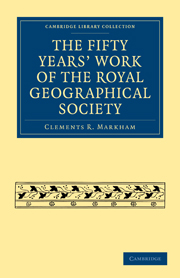Book contents
- Frontmatter
- Contents
- CHAPTER I THE FATHERS OF ENGLISH GEOGRAPHY
- CHAPTER II THE ROYAL SOCIETY
- CHAPTER III THE AFRICAN ASSOCIATION
- CHAPTER IV THE RALEIGH CLUB
- CHAPTER V FOUNDATION OF THE ROYAL GEOGRAPHICAL SOCIETY
- CHAPTER VI PRESIDENTS AND SECRETERIES OF THE ROYAL GEOGRAPHICAL SOCIETY, 1830–50
- CHAPTER VII PRESIDENTS AND SECRETARIES OF THE ROYAL GEOGRAPHICAL SOCIETY, 1851 TO 1881
- CHAPTER VIII EXPEDITIONS PROMOTED BY THE ROYAL GEOGRAPHICAL SOCIETY, AND GRANTS OF THE ROYAL AWARDS, 1830–55
- CHAPTER IX EXPEDITIONS PROMOTED BY THE ROYAL GEOGRAPHICAL SOCIETY AND GRANTS OF THE ROYAL AWARDS, 1855–1880
- CHAPTER X PUBLICATIONS OF THE SOCIETY—LIBRARY AND MAP ROOM—EDUCATIONAL MEASURES
- CHAPTER XI PROGRESS OF THE SOCIETY
- CHAPTER XII COMPARATIVE VIEW OF GEOGRAPHICAL KNOWLEDGE IN 1830 AND 1880, WITH A NOTICE OF THE WORK THAT STILL REMAINS TO BE DONE
- APPENDIX
CHAPTER XII - COMPARATIVE VIEW OF GEOGRAPHICAL KNOWLEDGE IN 1830 AND 1880, WITH A NOTICE OF THE WORK THAT STILL REMAINS TO BE DONE
Published online by Cambridge University Press: 29 August 2010
- Frontmatter
- Contents
- CHAPTER I THE FATHERS OF ENGLISH GEOGRAPHY
- CHAPTER II THE ROYAL SOCIETY
- CHAPTER III THE AFRICAN ASSOCIATION
- CHAPTER IV THE RALEIGH CLUB
- CHAPTER V FOUNDATION OF THE ROYAL GEOGRAPHICAL SOCIETY
- CHAPTER VI PRESIDENTS AND SECRETERIES OF THE ROYAL GEOGRAPHICAL SOCIETY, 1830–50
- CHAPTER VII PRESIDENTS AND SECRETARIES OF THE ROYAL GEOGRAPHICAL SOCIETY, 1851 TO 1881
- CHAPTER VIII EXPEDITIONS PROMOTED BY THE ROYAL GEOGRAPHICAL SOCIETY, AND GRANTS OF THE ROYAL AWARDS, 1830–55
- CHAPTER IX EXPEDITIONS PROMOTED BY THE ROYAL GEOGRAPHICAL SOCIETY AND GRANTS OF THE ROYAL AWARDS, 1855–1880
- CHAPTER X PUBLICATIONS OF THE SOCIETY—LIBRARY AND MAP ROOM—EDUCATIONAL MEASURES
- CHAPTER XI PROGRESS OF THE SOCIETY
- CHAPTER XII COMPARATIVE VIEW OF GEOGRAPHICAL KNOWLEDGE IN 1830 AND 1880, WITH A NOTICE OF THE WORK THAT STILL REMAINS TO BE DONE
- APPENDIX
Summary
The progress that has been made in the science of geography since the Society was founded is only partially shown by a comparison of an atlas of 1830 with the maps of the present day. For this progress is not alone comprised, in the discovery and delineation of unknown countries. Its range is far wider. There have also been great improvements in the methods of investigation, in systematic arrangement of facts, in cartography, and in the construction and use of instruments.
At the same time the most striking advances have been made in the work of discovery, and in completing our general knowledge of the earth's surface, preliminary to more systematic and detailed surveys. Yet, bearing in mind that the first discoveries are merely reconnaissances, it may safely be said that, great as our progress has been during the last half century, it only represents a very small fraction of what remains to be done.
Glancing first at the Arctic Regions, which had attracted so much attention during the period from the peace in 1815 to the attempt of Parry to push northwards from Spitzbergen in 1827, in 1830 only unconnected strips of coast line had been traced along the coast of Arctic America, and it was unknown whether there was a passage along that coast to Fury and Hecla Straits. Baffin's Bay had been re-discovered, and Parry had pushed westward along Barrow Strait to Melville Island, but nothing was known of the region between Barrow Strait and the continent.
Information
- Type
- Chapter
- Information
- The Fifty Years' Work of the Royal Geographical Society , pp. 116 - 126Publisher: Cambridge University PressPrint publication year: 2009First published in: 1881
